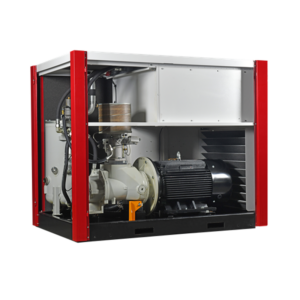Our Product
Gardner Denver
Gardner Denver Compressor
GDK-Series


Advantages at a glance
-
Low noise levelsAllows the compressor to be placed at the point of use
- High efficiency cooling system
Reliable operation, even in challenging environments - Self tensioning belt drive
Eliminate the risk of belt slip or loosening
Evenly distributing drive forces to provide balanced bearing load and belt wear
Ensuring peak performance and extending the life of the motor and air end
Compressor Airends
The airend on a compressor package is the component that takes in the air, compresses it and discharges it to the rest of the package. Using 37kW as an example, you can utilize a small airend (small rotor diameter), turn it at a relatively fast speed (revolutions per minute) and use about 37 kW worth of power.
Alternatively, you can make the airend larger which allows it to rotate at a slower rate while still utilizing about 37 kW worth of power. Thus, the airend size (and cost) for different 37 kW compressors will vary significantly.
It is fairly common for a manufacturer to offer a compressor with a smaller, faster rotating airend and a model with a larger, slower turning airend at the same kW because the larger airend is generally more energy efficient than the smaller airend.
Since the electrical cost of operation is the largest expense associated with operating a compressor, the larger airend will save reduce running costs over time, in many applications where power consumption is a key factor. In providing this size/speed offering in the same flow range, the customer can select the model that best meets the budgetary and operating cost targets that have been set.
Fixed vs. Variable Speed
Nearly every manufacturer offers customers both fixed and variable speed compressors in most size ranges. In general, variable speed (VS) compressors are applied when air demand varies significantly throughout a shift. This is because the VS compressors are more efficient (i.e. use less power (kW) per m3/min of air produced) than their fixed speed (FS) counterparts at part load (i.e. when the air system does not need all the air the compressor could make). Once you determine whether you need a FS or a VS compressor (or a combination), it is then most important to compare the efficiencies of the units involved. Be cautious in this area as many times VS compressors are recommended when they are not needed or do not project a reasonable ROI. Just because the VS compressor is the latest technology does not mean it is always the best compressor for the job. It is important to keep in mind that many times it is best to divide the air requirement between two or more compressors. In addition to providing some compressed air if one unit goes down, a multiple unit arrangement is often the most efficient design. And, this arrangement frequently combines fixed and variable speed units working together.
Single vs. Two-Stage
Two-stage lubricated rotaries compress air in two steps. Step or stage one takes atmospheric air and compresses it part way to the discharge pressure target. Step or stage two ingests the air at the inter-stage pressure and compresses it to the discharge pressure target. Compression in two stages improves efficiency, but adds cost and complexity given the additional rotors, iron and other componentry involved. Two-stage is generally offered in the higher kW sizes (above 75kW) because the improved efficiencies result in larger cost savings when air use is large. When comparing single stage versus two-stage, it is a relatively straightforward calculation to determine what the payback will be from the more efficient but more costly two-stage unit. Remember that the energy cost of operating a compressor is the largest expense over time, so evaluation of a two-stage machine is certainly worth a look.
Verified Performance
As a member of the Compressed Air and Gas Institute’s performance verification program, you can rest assured that the performance numbers that Gardner Denver publishes are consistent with the actual performance of our machines. Gardner Denver compressors, just as all lubricated rotary screw compressors 2.5 kW and above, are rigorously tested to ensure that our performance numbers are accurate, easy-to-understand and verified.
Beyond the Compressor: Downstream Products & Aftermarket Support
A healthy compressed air system requires much more than just an air compressor. Gardner Denver offers an extensive line of downstream equipment such as dryers, filters, chillers, piping and much more to complete your system. Our dedicated distributor network provides OEM parts, service and support to keep your system running for years to come. Using parts that are specifically designed for your equipment and only allowing authorized, certified technicians to provide you service, will not only protect your equipment investment, but also result in more efficient, reliable operation.
Your Compressed Air System Expert and Extensive Distributor Network Provides Peace of Mind
Gardner Denver is a market-leading, global manufacturer of compressed air systems backed by an extensive authorized distribution network conveniently located, ready to serve our customers. We offer comprehensive compressed air system solutions built with world-class manufacturing. Each of our industrial air compressors is researched, designed, and assembled by a world-class team. Our simple, but bold warranty programs demonstrate our belief in the quality found in Gardner Denver industrial air compressors. Gardner Denver authorized distributors are factory-trained and certified to support your compressed air system. They offer 24-hour service and technical support to address your needs quickly and easily.